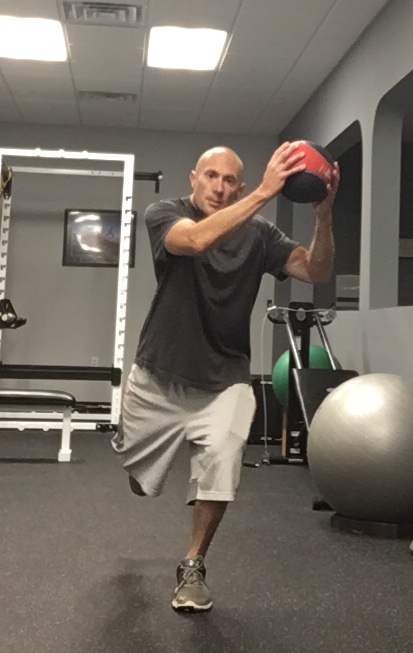The gluteus maximus is the most powerful hip extensor. This is important for functional activities performed in one plane such as walking, running, and climbing stairs. However, this muscle also has important functions outside of straight ahead planes of movement. The gluteus maximus also helps control balance and generate power in other planes. Rotational and lateral movements in everyday life and sport require important contributions from the gluteus maximus.
Training the gluteus maximus should incorporate single-plane hip extension exercises and exercises in multiple planes. Single-plane exercises such as the squat and hip hinge do not fully develop the glutes. Training programs should also include exercises with rotation of the trunk or lower body on one leg. These types of exercises prepare athletes for changes or direction, throwing, and jumping from one leg. Performance improvements and reduced risk for injury often occur with long-term training in multiple planes. The five exercises included in this article are only examples. Many other exercises can be adapted to train the entire body with rotational movements.
Crossover Step Up
The crossover step up helps expose and improve any side to side difference in gluteus maximus strength. Stand to the side with your left leg next to an elevated step or box. Cross your right foot in front and step up onto the box. Keep your hips square throughout the exercise. Next, cross your right foot behind the left while stepping down to briefly touch the floor on the opposite side. When descending think about sitting back into the hips. Reverse the movement in the opposite direction. Perform the exercise slowly with control. The challenge of the exercise can be increased by holding a dumbbell or kettle bell in the hands or close to the chest.
1-Leg RDL
The single-leg Romanian dead lift (RDL) is a single-leg exercises which requires stabilization of the trunk on the lower limb in multiple planes. These exercise begins by standing on one leg with the opposite hip and knee extended. The weight bearing knee can be slightly bent throughout the exercise. Initiate the movement by slowly flexing at the hip, keeping the back straight. The non-weight bearing leg extends straight back behind the body. Both the descending and ascending parts of the exercise should be performed in a slow and controlled manner. Also, maintain control and the position of the weight bearing leg during the exercise. Perform 8-10 repetitions on one leg before switching sides. The challenge of the exercise can be increased by holding a dumbbell or kettle bell in the hand on the side of the swinging leg.
Transverse Lunge
The transverse lunge starts standing with the feet near each other and hands on the hips. Throughout the exercise the trunk is maintained in an upright position, so the knee and hip of the lunging leg can be flexed to 90°. This prevents the knee from moving forward past the toes. Also, the knee remains over the toes so it does not cave inwards into valgus. During the transverse lunge, the body is rotated 135° towards the lunging side. This involves twisting behind the body and lunging in one motion. Add load by holding a dumbbell or kettlebell in the hand opposite the lunging leg or against the chest. This exercise shows high activation of both the gluteus maximus and gluteus medius.
Skater Squat
The skater squat introduces rotation of the trunk on the lower limb. The exercise begins by standing on one leg and performing a squat to a comfortable depth. The depth is determined by the ability to maintain balance and good control of the trunk and entire lower extremity. The non-weight bearing leg extends at the hip and flexes at the knee. The torso slightly rotates and the arms swing reciprocally as if skating. The toe of the non-weight bearing leg can touch the floor between repetitions if needed. Hold the downward position for 2 seconds then return to the starting position. Add load by placing a resistance band around the thighs just above the knees.
Rotational 1-Leg Squat
The rotational 1-leg squat is a progression of the skater squat. Both exercises have a rotational component to the squat. This exercise further challenges the balance and stability of the hip. Begin by balancing on one leg holding a medicine ball in both hands. The non-weight bearing knee and hip flex to approximately 30°. Slowly lower toward the floor being sure to maintain control of the trunk and supporting leg. The depth of the squat is determined by the ability to maintain balance and control the movement. Rotate the hands and medicine ball upwards and towards the weight bearing leg as you perform the squat. Return to the starting position and keep the knees over the toes to prevent knee valgus throughout the exercise.
Glutues Maximus Exercise: Closing Thoughts
Gluteus maximus weakness is common in those with chronic back pain, hip bursitis, hip arthritis, knee arthritis, and runner’s knee (patellofemoral pain). Training the glutes primary function of hip extension is important but often not enough for most demands of sport and everyday life. These five exercises are challenging and not for everyone. If you are unable to maintain balance and stability on one leg try other exercises first (basic gluteus maximus exercises). If you are still unsure how to start, contact your physical therapist for help.

